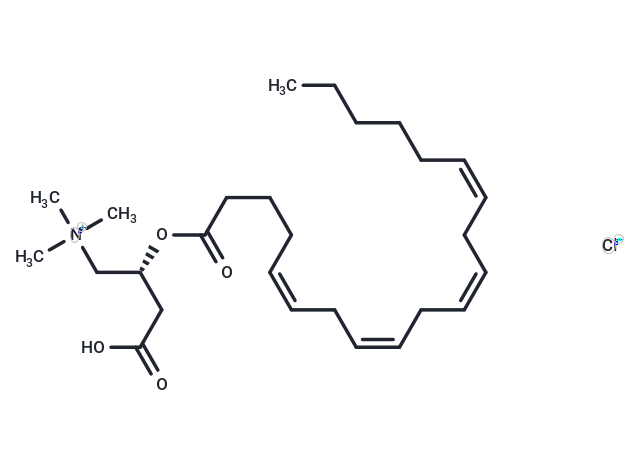Shopping Cart
Remove All Your shopping cart is currently empty
Your shopping cart is currently empty
Arachidonoyl-L-carnitine chloride is an endogenous metabolite and acylcarnitine widely used in biochemical experiments and studies of metabolic disorders.

| Pack Size | Price | USA Warehouse | Global Warehouse | Quantity |
|---|---|---|---|---|
| 10 mg | $226 | Inquiry | Inquiry | |
| 25 mg | $400 | Inquiry | Inquiry | |
| 50 mg | $740 | Inquiry | Inquiry |
| Description | Arachidonoyl-L-carnitine chloride is an endogenous metabolite and acylcarnitine widely used in biochemical experiments and studies of metabolic disorders. |
| Synonyms | L-Carnitine arachidonoyl ester chloride, L-Arachidonoylcarnitine chloride, CAR 20:4 chloride, C20:4 Carnitine chloride |
| Molecular Weight | 484.11 |
| Formula | C27H46ClNO4 |
| Cas No. | 2133455-98-6 |
| Smiles | [C@H](OC(CCC/C=C\C/C=C\C/C=C\C/C=C\CCCCC)=O)(C[N+](C)(C)C)CC(O)=O.[Cl-] |
| Storage | store at low temperature | Powder: -20°C for 3 years | In solvent: -80°C for 1 year | Shipping with blue ice/Shipping at ambient temperature. | ||||||||||||||||||||
| Solubility Information | Ethanol: 20 mg/mL (41.31 mM), Sonication is recommended. DMF: 15 mg/mL (30.98 mM), Sonication is recommended. DMSO: 5 mg/mL (10.33 mM), Sonication is recommended. PBS (pH 7.2): 5 mg/mL (10.33 mM), Sonication is recommended. | ||||||||||||||||||||
Solution Preparation Table | |||||||||||||||||||||
DMSO/PBS (pH 7.2)/DMF/Ethanol
| |||||||||||||||||||||
| Size | Quantity | Unit Price | Amount | Operation |
|---|

Copyright © 2015-2025 TargetMol Chemicals Inc. All Rights Reserved.